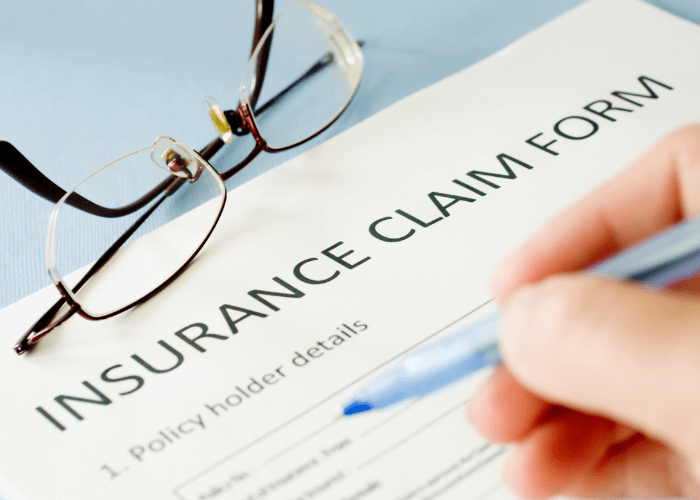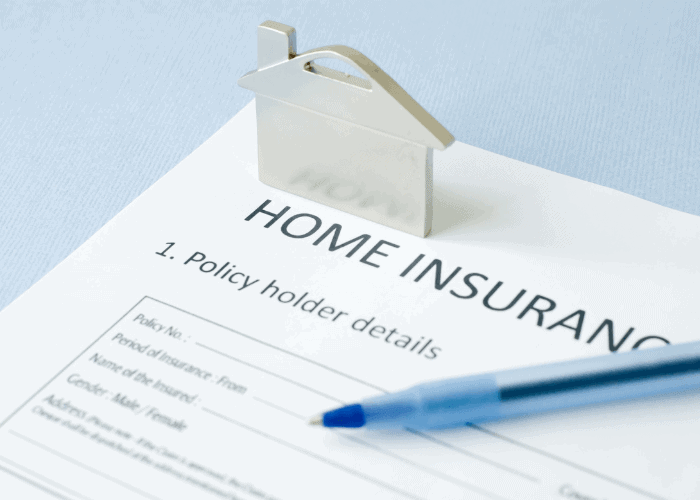Will Homeowners Insurance Cover HVAC?
By My Service Depot on Thursday, September 1, 2022How to get started filing a claim, what homeowners insurance could potentially cover (including your HVAC system), and the types of policies available.
When it comes to homeowners insurance, there are a few things that are important to understand. First, not all policies are created equal – it’s important to research many different insurance companies and their policy options to be positive you find the right fit for your needs.
The perfect policy can save you in more than one way if something bad were to happen. Your house and the property inside are important and should be insured using the best policy for you.
It is also important to understand what happens if you don’t have homeowners insurance. In most cases, if something happens to your home and you don’t have insurance, you will be responsible for the costs of damage.
Depending on the issue at hand this can get pricey very quickly. If it’s simply a broken outlet that burns out some cheap electronics then it may not be too bad. But if a pipe suddenly bursts, flooding the entire bottom floor and ruining everything inside it, the price can inflate significantly.
Finally, if something does happen and you need to file a claim, it’s important to know the process and what to expect. Often times people struggle to understand how to file a claim or what to file it on.
In this blog we will cover some of the basics on how to get started filing a claim, what homeowners insurance could potentially cover (including HVAC), and types of policies available.
Types of Policies
There are different types of homeowners insurance policies, and each one has its own specific benefits and features.
HO-1: Basic Form
Provides coverage only for damage or loss caused by 10 specifically named perils. These perils include fire or lightning, windstorm or hail, explosion, riot or civil commotion, aircraft, vehicles, smoke, vandalism and mischief, theft, and volcanic eruptions.
Damage or loss caused by events that are not specifically listed are not covered. HO-1 insurance isn’t recommended for most people and some insurance carriers no longer even offer these policies.
HO-2: Broad Form
This policy will typically cover everything that is covered by an HO-1 policy, plus additional coverage for perils such as damage caused by the weight of ice or snow on a structure, the accident overflow of discharge of water or steam, freezing, cracking or bulging caused by a sudden and accidental event, power surge, and falling objects.
Individual HO-2 policies may provide coverage against additional named perils, depending on the company. These policies are more common than HO-1, but due to their limited coverage less common than HO-3 or HO-5.
HO-3: Special Form
Also known as special form coverage, this is the most common type of homeowners insurance. This policy provides coverage for the structure of your home, your personal belongings, and liability protection.
Under HO-3 insurance, your home will typically be covered at its replacement cost, while your personal property will be covered up to its actual cash value. An endorsement can in most cases be added to your policy to provide replacement coverage for your personal property for an additional cost.
HO-3 is a good choice for most homeowners as it covers a wide variety of incidents. It will provide coverage for your home against damage caused by any peril except for those specifically excluded in the policy.
Some perils commonly excluded from an HO-3 policy include earthquakes, floods, neglect, landslide/mudslide, nuclear accident, sinkhole, act of war or government action, among others.
HO-4: Contents Broad Form
This form of insurance is commonly known as renter’s insurance. HO-4 policies are specifically designed for people renting or leasing an apartment, home, or condo. It covers a renter’s personal property (at its replacement cost) against the same named perils found in an HO-3 policy.
The other benefit that it provides is that it will typically provide living expenses if the rented property becomes unlivable caused by a disaster such as a fire.
HO-5: Comprehensive Form
The HO-5 is similar to the HO-3 but offers even more coverage and has some added benefits like how they determine the value of your home. This is a comprehensive policy that often offers the highest level of coverage for single-family homes.
Both your home and your belongings will be covered at their replacement cost (which is typically higher than cash value). In most cases, this policy will come with higher coverage limits for certain types of personal property, such as art, jewelry, and electronics.
HO-6: Unit-owners Form
This is a special type of policy designed for those who live in either a co-op or condominium. Typically the condo association will hold HOA insurance that covers the condo building itself and some shared areas.
As the unit owner you will need to purchase coverage for all the things that the HOA does not insure. This will often include coverage for any renovations, upgrades, or improvements made to the unit after you purchased it. It also covers personal property, loss of use, personal liability, and more.
HO-7: Mobile Home Form
This policy, also known as a mobile home policy (MHP), is designed to provide the same coverage as an HO-3, but for a mobile home. This is because mobile homes are not covered under an HO-3 policy.
The HO-7 covers a wide-range of mobile home structures including single and double-wide. Mobile home coverage may also be available in the form of an endorsement on another policy, such as an HO-3 or HO-5.
HO-8: Modified Coverage Form
This policy is generally for homes at high risk of loss or damage, or has a replacement cost that is higher than the actual cash value of the home. An HO-8 provides coverage against the same named perils as an HO-1. The amount of coverage offered by the policy will be based on the home’s actual cash value and not its replacement cost.
For a deeper dive, there is a fantastic and extensive list provided by Matic of the different types of homeowners insurance policies.
It’s also important to note that similarly to other insurance types, most homeowners’ policies have a deductible, which is the amount of money you will have to pay out of pocket before your insurance coverage kicks in. Deductibles typically range from $500 to $1,000, but they can be higher depending on the type of policy you have.
How to File a Claim

If something does happen and you need to file a claim with your homeowner’s insurance company, it’s important to know the process.
Typically, you will need to provide documentation of the damage to the company. This can include pictures, video, or even an estimate of the repairs that need to be done.
Many companies will send an inspector to assess the damage in order to get a better understanding of what needs to be done and to ensure they have all the correct information needed.
After the inspection is complete, the insurance company will usually provide you with a claims adjuster who will help you through the rest of the process. They will work with you to get an estimate for the repairs and help you file a claim on your policy.
It’s important to remember that filing a claim may cause your rates to go up, so be sure to weigh the pros and cons before making a decision.
Is Your HVAC System Covered Under Your HOI Policy?
Homeowners’ insurance policies do not usually cover HVAC systems that are not installed by a licensed professional. While HVAC systems are sometimes covered under homeowners insurance policies, the amount of coverage they have depends on the policy itself.
Some policies like an HO-1 may cover the system but only under very specific circumstances. If there is a power surge or some other electrical issue and your HVAC system gets damaged, your HO-1 policy will not cover that damage. This means you will need to fork over the money out of pocket if you plan on repairing or replacing the system.
On the other hand, if you had a policy that offered additional coverage, like an HO-2, the HVAC system could be covered if it was damaged by something like a power surge. Your homeowners insurance may also cover your HVAC system if the damage is caused by high winds, fallen trees, theft, hail, or even a fire.
A standard homeowners insurance policy will not cover an HVAC unit, especially if the damage is due to general wear and tear, owner neglect, or old age.
Meanwhile, policies like HO-3 and HO-5 are going to be the most common and offer the best coverage for your HVAC systems if it is damaged due to a covered peril or disaster.
Remember, there are many forms of peril that are commonly excluded from a policy, such as an earthquake, neglect, or flood.
Consider a Home Warranty
If you are considering purchasing a home and would like to have coverage for your HVAC system, you should consider a home warranty. Home warranties are separate from homeowners insurance and cover systems and appliances in your home that may break down over time. Many home warranty companies offer plans that include HVAC coverage which can be a great way of having added coverage.
Why Homeowners Insurance Is Important

If you don’t have homeowners insurance and something disastrous happens, such as a fire, you will likely have to pay for the repairs or replacements out of your own pocket. Without homeowners insurance, you could end up spending thousands of dollars on repairs or replacements that you weren’t prepared to spend.
Most people think of homeowners insurance as a way to protect their homes in case of an emergency. And while it certainly does that, homeowners insurance is also important for other reasons.
It can protect you from accidents. If you accidentally start a fire in your home, your homeowner’s insurance will help cover the costs of repairing the damage. It can also help cover the costs of replacing your belongings if they are damaged or lost in a fire or other type of accident.
Having coverage on accidents is important because they are easy to make and they are just that, ACCIDENTS! Sometimes accidents happen and having that protection can help save you some extra money.
Liability
Another reason homeowners insurance is important is that it can help protect you from liability. If someone gets injured on your property, your homeowner’s insurance will help cover the costs of any legal fees that may arise. This is important if you are holding lots of family gatherings or any types of parties frequently at your home. At events, it’s not uncommon for people to do something risky and get themselves hurt.
So, while most people think of homeowners insurance as a way to protect their homes from emergencies, it can actually provide protection for many different situations.
Theft
Most homeowners insurance policies will cover theft but only to a certain degree, items like valuable jewelry, art, and other sentimental items won’t be covered under the policy as they cant reasonably help replace these items.
Home invasions where theft is involved are a real issue. Even if you live in a safe neighborhood, there is always that possibility. While this isn’t something to be worried about because it’s simple to prevent, it’s important to have the proper protection for your household items for that rare occasion.
How Much Coverage Do You Need?

You may be wondering how much coverage you need for your home. Well, this ultimately depends on how much coverage you want. If you live in an area where earthquakes and other similar types of disasters happen often you may want to get a higher level of coverage as you are at a higher risk.
Some policies won’t cover events like these which makes it even more important to have better coverage so if an earthquake or a flood does happen you will have the necessary coverage for your home and the items in it. For most people, an HO-3 will have all the coverage you need but if you feel this does not meet your requirements you may want to consider an HO-5 for a higher-level insurance policy.
Conclusion
There is a lot to know about homeowners insurance, from filing claims to the many different policies available to choose form. The type of coverage you want will depend on your needs.
A standard homeowners insurance policy will not cover an HVAC unit, especially if the damage is due to general wear and tear, owner neglect, or old age. If you had a policy that offered additional coverage, like an HO-2, the HVAC system could be covered if it was damaged by something like a power surge. Your homeowners insurance may also cover your HVAC system if the damage is caused by high winds, fallen trees, theft, hail, or even a fire.
Here at Smart Service, we don’t offer insurance, but we do offer field service software. Our software, like insurance, can provide your business with peace of mind. It will eliminate double data entry and streamline everyday work processes like scheduling and dispatching. If your business is in need of improvement, try a free demo today and see for yourself all of the different ways that it can help.


